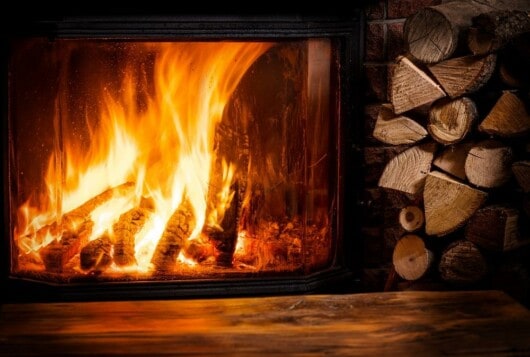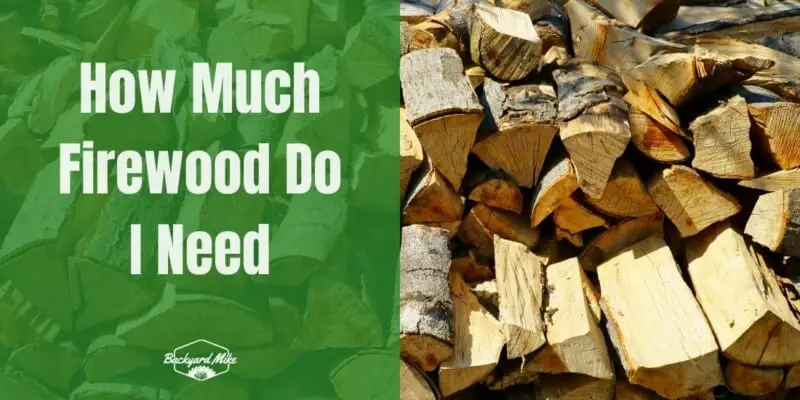Do you often wonder how much firewood do I need when preparing for cold winters? Me too. This isn’t only normal, but it is also necessary. You need to prepare yourself beforehand so that you can combat the winters and keep yourself warm.
How much firewood you’ll need for the winters will depend on multiple factors. These factors include the area where you live, how big your house is, how you’ll be utilizing the firewood, and more. If you’re someone preparing for the winters and looking for the aid of firewood, then you must read this article. Here, you’ll get the answers to how much firewood do I need, how to store the firewood, and more.
How to measure firewood?
Before getting the answers to how much firewood do I need, you need to know about cords. In the USA, firewood gets sold by the “cord”, which is something not measured by any kind of metric unit. A cord is defined as a stack of wood 4 feet deep, 4 feet tall, and 10 feet long. Outside of the USA, people prefer using a metric system called a “stère”, which is 1 cubic meter.
The measuring system for firewood isn’t as simple as straightforward as the metric system. In the USA, firewood is sold in “full cords” and “face cords”. In most states in the USA, the cord will be defined by a state statute, so it could vary from region to region. The technical definition of a full cord is a cord with a volume of 128 cubic feet. This volume will include the wood, air, and bark when the wood is in a pile. Due to that, the volume of the actual wood in full cords could vary between 80 and 100 cubic feet. In many cases, individual pieces of firewood could be around 16-inches.
A face cord, on the other hand, is 1/3rd of a full cord. The stack will generally be four by eight feet, which gives a volume of 42.5 cubic feet. The presence of air and bark could make it hard to predict the exact volume and how much wood is actually there. With that said, cords are still the best way of estimating firewood.
How much firewood do I need?
When you’re heating your house or enjoying fires during the winters, you ought to know how much firewood you need. According to census data, almost 2% of all US households are heated with firewood via fireplaces, wood boilers, or wood stoves. This amounts to over 2.5 million homes relying on firewood for heating purposes.
If your house is one of them or if you need indoor/outdoor fireplaces for warmth, you should have enough firewood. You must calculate how much firewood you’ll need to buy and store before seasoning for the winters.
Different sized houses will require different quantities of firewood. Here are a few examples of how much wood you’ll require to heat your house. You ought to know how you can get enough firewood for a large home and an average-sized home.
How much firewood you’ll need for a 15-room house with 2 stories and 1 fireplace
Many residents have stated that a 1000 sq. ft. house goes through almost three cords of wood during the winters. Using it as a baseline, assume that the 15-room house is around 4,000 sq. ft. By that measure, you will need to have about 12 cords. It would be a great idea to purchase more than you think you will need.
How much firewood you’ll need for a 5-room house with 2 stories
Assuming that your 5-room home is around 2,000 sq. ft. you will require around 6 cords of wood. Moreover, it would be better to overestimate than underestimate. Overall, you will require multiple cords of firewood for making it through the entire winter. Sometimes, you may need 10 cords or more. Either way, you will need to purchase more than what you’ve estimated.
While you’re obtaining your firewood for winter, you should consider trimming the trees to extend the lifespan of your trees and maintain their overall health.
Important factors that define how much firewood you’ll need
Is your fireplace your primary source of heat
The amount of firewood you’ll need for winters will depend on whether your wooden furnace is the primary heat source or if it is a decorative fireplace. For people residing in the countryside, chances are that their fireplace will be the primary source of heat. In that case, it is essential that you have ample firewood for your house. However, remember to have a larger pile of firewood than a decorative fireplace.

The size of your place
The size of your house is something you should keep in mind when deciding how much firewood to stock. For a 1000 sq. ft. house, you’ll need an average of 3 cords a season. Similarly, if you have a huge house, something around 4000 sq. ft. house, you will need around 12 cords for a regular winter. For a medium-sized house that is 2000 sq. ft., stocking 6 cords will be enough.
Density and dryness of the wood
Another key factor that you should keep in mind is the density and dryness of the wood. In fact, Penn State University recommends the use of hardwood with a moisture content of around 20%. Most hardwoods will burn at similar values, whereas softwoods will burn faster and release less heat over time.
Utah State University experts have gathered data regarding the types of timber and the British Thermal Units (BTUs) per cord. If a cord of basswood weighs 1,984 pounds, it’ll produce around 13.8 million BTUs when burnt. Meanwhile, a cord of maple wood will weigh 3,680 pounds per cord, it’ll produce 25.5 million BTUs when burnt.
Maple is around 2x as dense as basswood and will burn to produce 2x as much heat. This means you’ll get a better value for money. You should stock 2-3 cords of the densest wood possible and easily withstand the cold winters. While denser wood will mean that it’ll be harder to ignite, it’ll burn longer and hotter once it begins burning. It means that if you’re able to maintain fire continuously, you’ll be able to net the maximum amount of warmth.
Frequency of usage
Do you need to use firewood daily for extended hours? If you have to keep the fire burning for the majority of the day, then stockpile a lot of firewood. Stockpiling more than you need will be important, as you will not run out of firewood.
2-3 cords per season will be more than enough for you. However, it would be better to purchase a bit more than necessary if there are long winters.
However, if you’re using the fireplace only during the evenings, then you won’t have to purchase a lot of firewood. A single cord will be more than enough for the winters.
Buying and storing firewood for winters
Different types of woods come with varying densities. The wood between mid to high density (hardwoods) is far more desirable as they burn slower while also creating less smoke. Some examples of hardwood include oak, ash, maple, and walnut.
Some examples of softwoods include pine, larch, fir, and hemlock aren’t recommended as they burn hot and fast. The higher burn temperatures can potentially damage wood-burning stoves. Further, the faster rate will make them less cost-effective. These will also produce more smoke while contributing to the buildup of soot and ash in chimneys. This is the case because of the high volume of sapwood they contain.
If possible, you should inspect the wood thoroughly before you buy it. This way, you’ll be able to ensure the high-quality of the wood that you’re buying. Further, you’ll also need to ensure that the wood is stacked neatly and properly and being sold by the cord.
When you’re storing firewood, it would be best to keep the wooden pile 20 feet from the nearest door. This keeps the pests and small rodents away and doesn’t give them a path from the woodpile to your house. Further, never stack the wood directly on the ground. Instead, you should make use of wooden pallets or a firewood rack to keep the wood off the ground. This allows for proper airflow while also cutting down on the insects. You shouldn’t spray the wood with pesticides, as you wouldn’t want to burn the pesticide chemicals inside the house.
If you’re stacking wood, you should allow the wind to generate proper airflow parallel to the length of a split log. This will give a faster, more effective seasoning process. You should make use of a tarp on the top for protection against rain. However, leave the sides of the pile partially exposed for allowing proper airflow. It would be a smart idea to have an organizational system such that you’re using older, dryer wood first.
If you’re thinking of storing seasoned wood next to the stove for easy access, you should take special care. Avoid storing the wood within 36 inches of the stove as a safety precaution. If you have a freestanding fireplace or wood stove that features a designated wood storage pedestal, it would be safe to store wood there. Generally, you should be careful and read the manufacturer guidelines to get detailed information for wood storage clearance.
Conclusion
Thank you for reading. Hopefully, now you have the answer to important questions like how much firewood do I need for winters. Ultimately, it’ll allow to come down to how frequently you’ll be using firewood, how big your house is, the density of the wood, and more. Always remember to gather more cords of firewood because a little extra will not hurt you. Store the firewood and season it ahead of time so that by winter you have firewood ready to be used.


